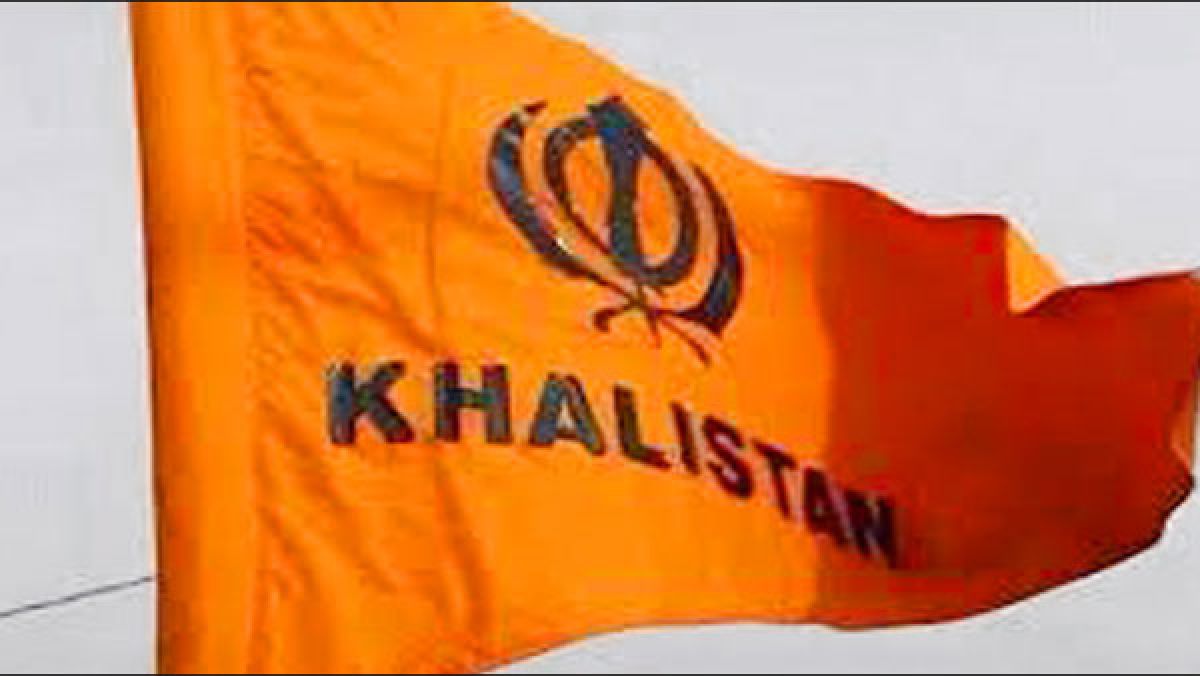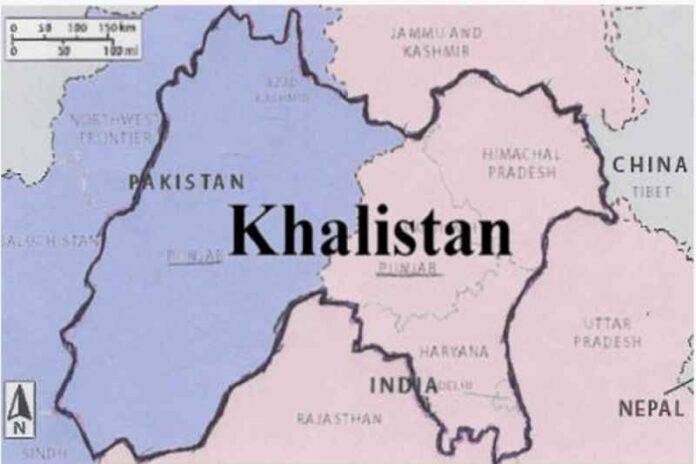News
- Members of Khalistani secessionists profaned the statue of Mahatma Gandhi during a kick organized by Sikh- American youths outside Indian delegacy in the USA.
Khalistan
- The Khalistan movement is a Sikh separatist movement seeking to produce a motherland for Sikhs by establishing an autonomous state, called Khalistan( Land of the Khalsa)
- The proposed state would correspond to land that presently forms the Punjab region in India and Pakistan.
Elaboration Of Issue
Pre-Independence
- The Punjab region has been the traditional motherland for the Sikhs. Before its subjection by the British, the region had been ruled by the Sikhs nearly 100 times.
- In the 1940s, when the Lahore Resolution of the Muslim League demanded Punjab to be made into a Muslim state, a section of Sikh leaders, led by Akalis, grew concerned. They put forward the idea of Khalistan as a theocratic state covering the lesser Punjab region.
Early days of Independence
- The fight for a individual Sikh state owes its origins to the Punjabi Suba Movement. The Akali Dal – a Sikh- dominated political party – sought to produce a individual Sikh Suba or Province.
- Following the 1947 independence of India, the Punjabi Suba movement, led by the Akali Dal, sought the creation of a terrain for Punjabi people.
- But the States Reorganization Commission rejected the Akali Dal’s demand, stewing that creating a Punjabi- maturity state would effectively mean creating another state grounded on religious grounds.
- But after a series of violent demurrers, the Indira Gandhi government accepted the demand, and the Punjab Reorganisation Act was passed in 1966.
- The state was trifurcated into Punjabi- maturity Punjab, Hindi- maturity Haryana and the Union Territory of Chandigarh.
- Chandigarh was made a centrally administered Union home.
- Some hilly regions of the state were intermingled into Himachal Pradesh.
Still, several issues created resentment among Sikhs in Punjab participating in the capital of Chandigarh’s triplex agreement on sharing of fat waters of the Ravi and Beas gutters
1972- 1982 Khalistan Movement
- The 1972 election proved to be a blip in Akali’s political growth. The Congress swept to power, egging the Shiromani Akali Dal to introspect.
- To regain public appeal, the party put forwards the Anandpur Sahib Resolution in 1973. “The resolution document included both religious and political demands, like”.
- Creation of an independent region for Sikhs.
- Recognition of Sikhism as a religion individual from Hinduism.
- Transfer of Chandigarh and certain different areas to Punjab.
- Radical degeneration of powers from the Central to state governments The document gained attention in the 1980s when it set up a girlfriend in Jarnail Singh Bhindranwale – a religious scholar.
- Still, Bhindranwale represented the revolutionist view.
- If the Akalis were a moderate body espousing Sikh pride and politics. “In 1982, the Akali Dal and Bhindranwale joined hands to launch the ‘Dharam Yudh Morcha‘.”
- In 1982, Akalis blazoned that they would disrupt the 9th periodic Asian Games to be held in Delhi. While it had limited success, it helped numerous Sikhs sympathize with the Akali Morcha.
- Bhindranwale surfaced as the revolutionist voice of Sikhs, overruling the moderate voices of leaders who declared himself as the protection and arbitrator of Sikh rights.
- Wide murders by followers of Bhindranwale passed in 1980s Punjab, particularly against Hindus and Nirankaris. Following the murder of six Hindu machine passengers in October 1983, an exigency rule was assessed in Punjab. The Akali Dal began further agitations.
1984- Operation Blue Star
- In 1983, Bhindranwale and his followers took up hearthstone inside the Harmandir Sahib complex (aka the Golden Temple) in Amritsar. He converted the holy sanctum into a fortified fort from where he ran a virtual resembling government.
- To capture them, Operation Blue Star was carried out by the Indian army.
- The Army, equipped with tanks and heavy ordnance, rolled up to the Temple on 5th June.
But they faced stiff resistance from the zealots, who were armed with Chinese-made anti-tank and machine ordnance. - Operation Bluestar eventually ended in the autumn on 10 June 1984. According to the government, 493 zealots and civilians were killed in the attack.
- Clean-up operations, codenamed Operation Woodrose and Operation Black Thunder were initiated in the posterior times.
What Caused Khalistan to Rise
- Historical factors: The Punjab region has been the traditional motherland for the Sikhs. The acceptance of an Islamic maturity in Pakistan made a reason for the Sikhs to protest the demand for Separate Khalistan.
- Partition The Indo- Pak partition along the Punjab region doesn’t cleave to the artistic boundary. Large portions of the region got separated between the two countries. This created dissent amongst the people.
- Mixing of religion and politics: All major parties reckoned on the religious sentiments of people for their political earnings. sweats like the Anandpur Sahib resolution fueled regionalism and communalism.
- Radical leadership: Leaders like Bhindranwale traveled across Punjab backing a return to a more orthodox form of Sikhism. His communication appealed to the youth, who latterly came his avaricious followers.
- Foreign backing: The movement entered the patronage of not only the Sikh diaspora but also external actors like organized crime groups who wanted to destabilize India.
- Part of external state actors: To avenge the separation of Bangladesh, Pakistan covertly supported the Khalistan movement. Pak’s ISI handed training, arms, security, and safe havens to Khalistan.
- Government’s failures: Though it was known that zealots were taking sanctum in gurdwaras and amassing arms, the INC Government of India chose not to take action, for the fear of hurting Sikh sentiments. Also, intelligence gathered previous to the operation was limited, which increased the casualty rate.
- Failure of the green revolution: Bhindranwale’s communication appealed to the Jat peasants who had lost out on the earnings of the Green Revolution to large coproprietors.
Impact of the Events – Khalistan
Death of civilians: Operation Bluestar coincided with the periodic commemoration of the martyrdom of the fifth Sikh Guru, Guru Arjan Dev, which led to a large number of pilgrims swarming to the Tabernacle complex. Because of this, numerous innocent civilians were killed in the crossfire between the Indian Army and the terrorists.
Assassinations & screams
- On 31 October 1984, Prime Minister Indira Gandhi was assassinated by her two Sikh guardians.
- further than 8,000 Sikhs were killed in the preceding anti-Sikh screams in 1984.
- In June 1985, Canadian Sikh crazies blew up an Air India flight(Flight 182) killing all 329 people on board.
- On 10 August 1986, former Army Chief General AS Vaidya, who led Operation Bluestar, was assassinated by Sikh zealots of the Khalistan Commando Force.
- On 31 August 1995, a self-murder bomber took out Punjab Chief Minister Beant Singh inside the Punjab civil secretariat in Chandigarh.
- Rajiv- Longowal Accord In 1985, the Government tried to seek a political result through the accord. It agreed to establish commissions and independent bars in order to resolve the Chandigarh issue and the swash disagreement.
- mortal rights violation colorful mortal rights organizations have explosively blamed the Punjab police for their abuse of power during the 1980s and early 1990s.
- Creation of NSG The National Security Guard was created as an elite counter-terrorism unit following Operation Blue Star and the assassination of Indira Gandhi.
- Strain in India- Canada relations Canada has a large aboriginal population of Sikhs and has several active-Khalistan groups. Hence, Khalistan has been a thorny issue in Indo- Canadian relations.
Future of Khalistan Movement
At present, the Khalistan movement is asleep in India. But that doesn’t mean India can let down its surveillance, as
- There have been reports that ISI and Pakistan are trying to revive the movement to retaliate against India after its debacle on the Kashmir issue.
- The movement is getting ideological support from Sikhs living in Canada, UK, and USA.
- They’re funding groups that work for the reanimation of the secessionist movement.
- Also, some politicians have been using the Khalistan hobgoblin to downplay growers ’ demurrers and to give the rationale for a crackdown on protesters.
So, while the Khalistan movement is missing, security agencies must keep surveillance on frame sections and political parties should refrain its members from making filmy statements for bare media attention.
Khalistan Flag


